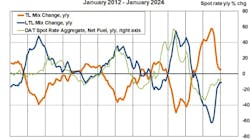The legislation that Nancy Pelosi once said had to be passed “so that we can find out what is in it” has passed. A recent webinar sponsored by the National Association of Trailer Manufacturers tackled the subject of telling National Association of Trailer Manufacturers members what is in it — and what they need to do about it.
The impact of the new healthcare law: 60% of employers surveyed by Mercer Human Resource Consulting expect some increase in cost; the employers that will be hit hardest are those with large part-time and hourly populations; and almost half (46%) of these employers anticipate a cost increase of at least 3% in 2014.
In the NATM webinar, “PPACA Impact: What Employers Need To Know Right Now,” Yvonne M Frame said that there is an individual mandate requiring that beginning in 2014, individuals will be responsible for purchasing coverage or electing through an employer's group health plan.
The Patient Protection and Affordable Care Act (PPACA), is not about reforming the health-care system itself, nor is it about lowering costs or changing the design of how health care is delivered, said Frame, a certified employee benefit specialist for Marsh & McLennan Agency LLC. “It's basically looking at creating access to health care.”
The law applies to companies with more than 50 full-time employees or one with a sufficient number of part-timers which the bill terms “full-time equivalents.”
“There is no specific requirement for an employer to offer coverage,” Frame said. “But, in 2014, employers with more than 50 full-time equivalents (FTEs) will be penalized if employees receive subsidized coverage on the Exchange. Even if employers do offer coverage, penalties can occur if coverage is not deemed ‘affordable.’ Companies with more than 50 FTEs are subject to the Pay or Play mandates/penalties. FTE includes both full-time and part-time employees — those working less than 30 hours per week.”
Companies with over 50 full-time equivalents (FTEs) will have to offer coverage or pay penalties.
“There will be an opportunity for individuals and smaller companies to purchase coverage through state health benefit exchanges,” she said. “Some health insurance practices will be prohibited or reformed. There will be new duties for employers.”
Questions to ask before 2014:
-
What if I don't offer coverage?
-
What if I don't offer affordable coverage?
-
What if I only offer coverage to certain classes of employees?
She said employers should understand a few key terms:
-
Grandfathered Plan: Grandfathered plans have not made substantial benefit reductions or employer-contribution reductions since March 23, 2010, including changing insurance carriers between March 23, 2010, and November 15, 2010. Non-Grandfathered plans are subject to additional provisions, including discrimination testing.
-
Health Insurance Exchange: Purchasing platform for standardized, guaranteed-issue health care plans. The exchanges will open to individuals and small businesses, effective January 1, 2014.
-
Subsidy: Tax credit available to certain individuals to help them purchase coverage on the exchange. Subsidies also available to reduce out-of-pocket benefit costs, such as coinsurance and deductibles.
-
The Federal Poverty Level is the baseline income amount for Medicaid and Subsidy eligibility.
-
FTE: Companies with more than 50 full-time equivalent employees are subject to the Pay or Play mandates/penalties. FTE includes both full-time and part-time employees (those working less than 30 hours per week).
Frame said the following rules are already in effect for all employer “group health plans”:
-
Prohibitions: lifetime and annual limits (exemptions through 2014 on annual limits); pre-existing condition exclusions for children under age 19; rescissions based on healthcare status; and required coverage of adult children up to age 26.
-
Increased penalty on non-qualified HSA distributions.
-
Over-the-counter medications without a prescription are ineligible for reimbursement under HSA/FSA/HRA.
Frame listed the information required on the Summary of Benefits and Coverage (SBC):
-
A description of the plan's coverage and cost-sharing requirements, coverage limits, deductibles, coinsurance, and copays, etc.
-
Facts regarding common benefits scenarios (eg, pregnancy, chronic medical conditions, etc).
-
A statement regarding whether the plan provides “minimum essential coverage” (a term that is not yet clearly defined).
-
A statement that the document is merely a summary, and that the terms of the plan control.
“Generally, the summary of benefits and coverage will be provided by the insurer for a fully-insured plan — third-party administrators should be working with employers for self-insured plans,” she said. “It applies to all open enrollments and/or all plan years that occur on or after September 23, 2012. Timing can be problematic if the fiscal year began around October 1, 2012, since most open enrollment periods will already have occurred for existing employees. Penalty for noncompliance is $1000 per failure. The delivery method can be by whatever ‘reasonable’ means necessary, though electronic delivery method is cumbersome because it requires ‘acceptance’ by the email recipient before the summary of benefits and coverage can be sent electronically.”
Changes in store
Additional 2012 changes:
-
Advanced Notice of Material Modifications: Starting September 23, 2012, plans had to provide participants with 60 days' advanced notice prior to any material modification not otherwise provided on the annual SUMMARY OF BENEFITS AND COVERAGE.
-
Patient-Center Outcomes Research Institute fees: $1 multiplied by the average number of covered lives under the plan for policy years or plan years ending on or after October 1, 2012, to be filed and paid on IRS Form 720 by self-funded plans by July 31, 2013. Insurers will build into renewals for fully insured plans.
Key compliance issues in 2013:
-
Increasing Medicare tax on employee wages AND for investment income earned for those above certain income thresholds (above $200,000 for single filers; $250,000 for joint taxpayers)
-
Cap on health FSA contributions is now $2500.
-
Employer notification to employees regarding health exchange options, effective March 1, 2013.
More changes in 2014: guaranteed issue coverage for all; exchanges open; expanded Medicaid eligibility (states can opt out of expansion); employer Pay or Play penalties; individual mandate; no pre-existing conditions, regardless of age; auto enrollment; expanded clinical cancer trial coverage; and waiting periods greater than 90 days are prohibited.
She said the exchanges tie in one-stop shopping, greater benefits and protections, lower costs, and increased competition.
“Although the exchange idea is universal, there are two essential types — to be separately designed by each state or the federal government if a state chooses not to implement a program: Small Business Health Options Program (SHOP), for employers of under 100 employees, and American Health Benefit Exchange, for all other individuals,” she said.
She said the IRS Safe Harbor guidance addresses “measurement periods” (look-back periods for counting hours) and “stability periods” (periods when workers must be treated as full time if they met requisite hours in the measurement period).
Employer options
Employers can: rely on a look-back measurement period (of three to 12 months) to determine whether ongoing and newly hired variable-hour or seasonal employees must be considered full time; take up to 90 days between a measurement and a stability period to facilitate enrollment; and define “seasonal employees” using a reasonable, good-faith interpretation, and treat them under the same rules that apply to variable-hour employees.
Ongoing employees' hours are counted over a standard (and generally the same) measurement period. Ongoing employees have worked through at least one measurement period.
“A new employee who is expected to work 30 hours or more per week must be treated as full-time,” she said. “Apply the variable-hour employee rules if full-time status cannot be reasonably determined. A variable-hour employee who averages at least 30 hours per week during an initial measurement period — generally from their date of hire — must be treated as full-time during the following stability period.
“You can use a measurement period of up to 12 months. It does not have to be the same as the stability period. The administrative period can be for up to three months, but must end by the last day of the calendar month beginning on or after the employee's anniversary date. The stability period must be the same as the ongoing employee stability period.”
Other longer-term compliance issues:
-
Individual mandate tax increases to $325 or 2% of household income over filing limit in 2015.
-
Individual mandate tax increases to $695 or 2% of household income over filing limit in 2016.
-
Large employers may participate in exchanges in 2017.
And then, beginning in 2018:
-
Cadillac tax: An excise tax on high-cost health plans. Thresholds: individual coverage, $10,200; and family coverage, $27,500. The tax equals 40% multiplied by the amount of coverage in excess of the threshold. It applies to the aggregate value of coverage (ie, fully loaded). Analysts project 60% of plans will be “Cadillac” plans by 2018.
She recommended that the next steps for companies are:
-
Review your plan eligibility: Do you offer coverage to all employees working more than 30 hours per week? If no, assess potential penalties.
-
Review your plan affordability: Does the annual premium exceed 9.5% of the federal poverty level? Do benefits meet at least 60% actuarial value? If no to either of these conditions, assess potential penalties.
-
Have you lost grandfathered status? If yes, perform an informal non-discrimination test to determine potential penalties. If no, perform an informal test prior to the loss of status to determine potential impact.
“Employers who are able to satisfy the non-discrimination testing may still find themselves subject to penalties under the Pay or Play mandate, and vice versa,” she said. “While non-discrimination testing is on hold, it is prudent to test prior to losing grandfathered status because of the number of low-wage employees. There is no requirement for employers to offer ‘dependent’ coverage under the employer Pay or Play provision, but the IRS may interpret that differently based on request for initial comments. While it may make sense financially to drop coverage and pay the penalty, does it make sense for employee recruitment and retention?”










